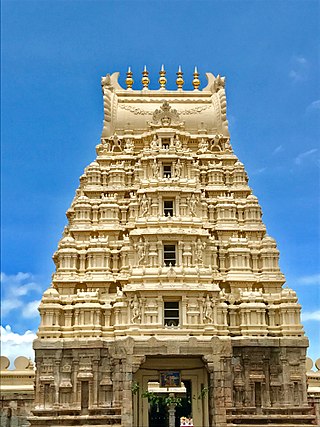
Srirangapatna is a town and headquarters of one of the seven Taluks of Mandya district, in the Indian State of Karnataka. It gets its name from the Ranganthaswamy temple consecrated around AD 984. Later, under the British rule, the city was renamed to Seringapatnam. Located near the city of Mandya, it is of religious, cultural and historic importance.
Sharpe is a series of historical fiction stories by Bernard Cornwell centred on the character of British soldier Richard Sharpe. The stories formed the basis for an ITV television series featuring Sean Bean in the title role.
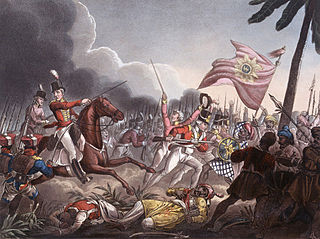
The Battle of Assaye was a major battle of the Second Anglo-Maratha War fought between the Maratha Empire and the British East India Company. It occurred on 23 September 1803 near Assaye in western India. An outnumbered Indian and British force, under the command of Major General Arthur Wellesley, defeated the combined Maratha army of Daulatrao Scindia and the Bhonsle Raja of Berar. The battle was Wellesley's first major victory and the one he later described as his finest accomplishment on the battlefield, even more so than his more famous victories in the Peninsular War, and his defeat of Napoleon Bonaparte at the Battle of Waterloo.

The Fourth Anglo-Mysore War was a conflict in South India between the Kingdom of Mysore against the British East India Company and the Hyderabad Deccan in 1798–99.

Gawilghur was a well-fortified mountain stronghold of the Maratha Empire north of the Deccan Plateau, in the vicinity of Satpura Ranges, Amravati District, Maharashtra. It was successfully assaulted by a force commanded by Arthur Wellesley on 15 December 1803 during the Second Anglo-Maratha War.

The siege of Seringapatam was the final confrontation of the Fourth Anglo-Mysore War between the British East India Company and the Kingdom of Mysore. The British, with the allied Nizam Ali Khan, 2nd Nizam of Hyderabad and Marathas, achieved a decisive victory after breaching the walls of the fortress at Seringapatam and storming the citadel. The leader of the British troops was Major General David Baird, among the lesser known allies were the Portuguese in Goa and Damaon. Tipu Sultan, the de facto ruler after the death of his father, who had usurped the throne of Mysore, was killed in the action. The British restored the Wodeyar dynasty back to power after the victory through a treaty of subsidiary alliance and Krishnaraja Wodeyar III was crowned the King of Mysore. However, they retained indirect control of the kingdom's external affairs.

Raghunathrao Bhat, also known as Ragho Ballal or Raghoba Dada, was the younger son of Peshwa Bajirao I who served as the 11th Peshwa of the Maratha Empire for a brief period from 1773 to 1774. He succeeded his Nephew Narayanrao.

Sharpe's Tiger is the fifteenth historical novel in the Richard Sharpe series by Bernard Cornwell and was first published in 1997. It acts as a prequel to the "original" Sharpe series, which begins in 1809, while Sharpe is a captain in the Peninsular War during the Talavera Campaign in Spain. In Tiger, Sharpe is a private in the 33rd Regiment of Foot, serving in southern India during the Siege of Seringapatam in 1799.
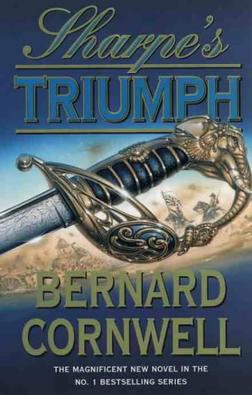
Sharpe's Triumph is the second historical novel in the Richard Sharpe series by Bernard Cornwell, first published in 1998. Sharpe is a sergeant in the army who attracts the attention of General Arthur Wellesley at Ahmednagar.

Sharpe's Fortress is the third historical novel of the Richard Sharpe series, by Bernard Cornwell, first published in 1998. It is the last of the Sharpe India trilogy. It tells the story of Ensign Sharpe, during the battle of Argaum and the following siege of the fortress of Gawilghur in 1803.

The Chittorgarh, also known as Chittod Fort, is one of the largest living forts in India. It is a UNESCO World Heritage Site. The fort was the capital of Mewar and is located in the present-day city of Chittorgarh. It sprawls over a hill 180 m (590.6 ft) in height spread over an area of 280 ha above the plains of the valley drained by the Berach River. The fort covers 65 historic structures, which include four palaces, 19 large temples, 20 large water bodies, 4 memorials and a few victory towers.
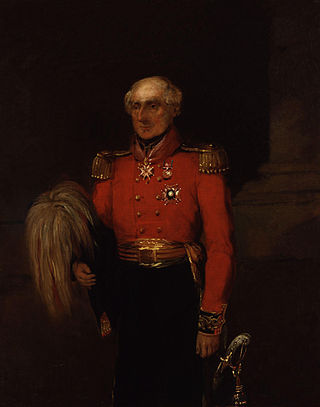
Lieutenant-General Sir Colin Campbell was a British Army officer and colonial governor.
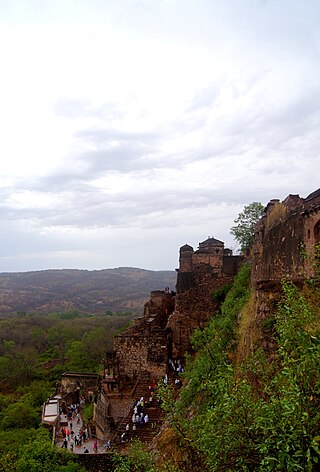
Ranthambore Fort lies within the Ranthambore National Park, near the city of Sawai Madhopur in Sawai Madhopur district of Rajasthan, India. the park being the former hunting grounds of the Maharajahs of Jaipur until the time of India's Independence. It is a formidable fort having been a focal point of the historical developments of Rajasthan. The fort is believed to be constructed by numerous kings from Several Dynasties including The Yadavas, Chahamana Rajputs, Hada Rajputs, Mewar Rajput Kings and then the Delhi Sultanate captured it for a brief time. The fort provides a panoramic view of the surrounding Ranthambore National Park and is now a popular tourist attraction.

Sharpe's Challenge is a British TV film from 2006, usually shown in two parts, which is part of an ITV series based on Bernard Cornwell's historical fiction novels about the British soldier Richard Sharpe during the Napoleonic Wars. Contrary to most parts of the TV series, Sharpe's Challenge, as well as the follow-up Sharpe's Peril, is not based entirely on one of Cornwell's novels, but it uses and adapts some characters and storylines from Sharpe's Tiger (1997). Both are set in 1817, two years after Sharpe has retired as a farmer in Normandy, so chronologically they come after Sharpe's Assassin (1815) and before the final novel Sharpe's Devil (1820–21). Some of the events in the film are inspired by events in the first three novels of the series. In Sharpe's Challenge and Sharpe's Peril, Sharpe and his comrade in arms, Patrick Harper, have been temporarily called out of retirement and asked to go to India.
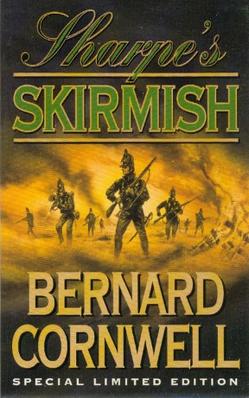
"Sharpe's Skirmish" is a historical short story by Bernard Cornwell in the Richard Sharpe series.

The Kingdom of Mewar, sometimes known as Udaipur State, was an independent kingdom in Rajputana region of India, ruled by the Sisodia dynasty. It originated in the form of the Guhila Kingdom in Mewar. In the 10th century, it transformed into an independent state under Rawal Bharttripatta II.

Narnala Fort or Narnala Qila Sarkar, also known as Shahnoor Fort, is a hill fortress in the Satpura Range of Vidarbh, Maharashtra, India, named after the Rajput Solanki Chaulukya Ruler, Raja Narnal Singh, also known as Narnal Singh Swami. It was renamed as "Shahnoor" by Islamic rulers but again acquired, rebuilt and got its name "Narnala" by ruler Rao Rana Narnal Singh Solanki, who migrated from Patan in Gujarat.

The siege of Chittorgarh was the military expedition of the Mughal Empire under Akbar against the Mewar kingdom that commenced in 1567 during which the Mughals successfully captured the fort of Chittorgarh after a hard-pressed siege which lasted for several months.

Sabalgarh Fort is a 16-17th-century hill fort near Sabalgarh, Madhya Pradesh, India. This fort is situated on a large rock in the northeastern part of Sabalgarh, The town was founded by Raja Sabal Singh. Presently, the fortress is in ruins and is infamous for stories of haunting and ghosts. The fort consists of a defensive structure and one main palaces and many other buildings. The fort has been controlled by a number of different rulers in its history.

















